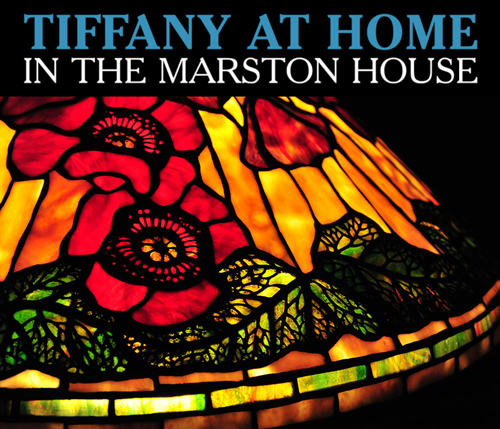|
Tiffany at Home at the Marston House
July/August 2021
Art interprets the beauty of ideas and of visible things, making them concrete and lasting. - Louis Comfort Tiffany
The Marston House Museum & Gardens is pleased to share the recent gift of three extraordinary stained glass and bronze Tiffany lamps that make stunning additions to the 1905 period home and enrich its early 20th-century decorative arts collection.
The beneficent gift includes two exquisite table lamps and an intricate floor lamp, all made at Louis Comfort Tiffany's Tiffany Studios in New York between 1905 and 1908.
 Photo by Sandé Lollis |
A splendid peony floor lamp (c. 1905) is a riot of intertwined flowers with rosy peonies bursting into the foreground atop a tall onion dome pattern base that unfurls into a heat cap and pig tail finial. The graceful poppy table lamp (c. 1906), one of Tiffany's most popular designs, is awash in predominantly ruby red blooms that float against a gold background and above a bower of green leaves.
In contrast, geometry reigns in the conical amber shade (c. 1906), a radiating pattern of narrow strips of glass in shades of gold and amber, with a twisted vine base.
All three lamps attest to the artisans' ability to work in the round, making the shades attractive from every side, in every room setting. They vie for attention in both natural light and the glow of colored light when illuminated.
Every Tiffany lamp was made by hand, using materials of the superb quality. They are known for their exceptional designs and handcrafted details, especially those drawn from nature, a favorite with Louis Tiffany and his customers. He sent cut flowers to the studio weekly to inspire the glass artists, who embraced them. The floral designs for lamps were among the most sought after and commercially successful items in Tiffany's catalog.
The bronze sculptural bases too were inspired by natural forms. The artistry of the bases can be as important as the shade; most were cast at Tiffany's foundry in Queens, New York.
Louis Comfort Tiffany's warm, jewel-toned creations in stained glass represent the highest quality and excellence of design and craftsmanship in American decorative arts. He is universally considered to be one of the most important American artists of the late 19th and early 20th centuries, throughout his career that spanned 57 years.
The son of Charles Lewis Tiffany, the legendary founder of the silver and jewelry firm Tiffany & Co., Louis, (1848-1933) made his mark first as a painter during the 1870s Aesthetic movement. He began working in glass while employed at Tiffany's. By the 20th century, he was not only a leading proponent of the Arts and Crafts movement, but one who put into practice William Morris's mandate to bring reasonably priced "useful beauty" to every home.
Tiffany employed a host of craftsmen, both men and women. A cache of letters discovered about 15 years ago revealed the glass studio's team of female designers and artists, the self-proclaimed "Tiffany Girls." Head designer Clara Wolcott Driscoll (1861-1944), the letter writer who was hired after Tiffany spotted her work at the Metropolitan Museum Art School, directed the Women's Glass Cutting Department. She is believed to be the designer of the inspiring and complex peony and poppy floral lampshades.
Louis Tiffany was a proponent of women in the arts and the workplace. He was a founding member of the Society of Decorative Arts in New York in 1877, with friend and partner Candace Wheeler, often credited as the "mother" of interior design. As one of America's first woman interior and textile designers, she and Louis co-founded the interior-decorating firm of Tiffany & Wheeler. The Society of Decorative Arts was meant to help women support themselves through handicrafts such as needlework, sewing, and other decorative arts with a special focus on the thousands of women who were left indigent at the end of the Civil War.
Louis Tiffany would have found a fellow progressive in George Marston, who by 1910 would boast that women held 45 percent of the executive positions at Marston's department store.
"Tiffany's work reflects the efforts to resolve the conflicting ideals of the Arts and Crafts movement. William Morris, its English protagonist, had demanded: 'What business have we with art at all unless all can share it?' Yet most companies could not produce affordable art for the home while retaining high standards and individual expression. Tiffany, however, successfully created an art industry. He triumphed where others had failed because his personal fortune allowed him to sacrifice company profits in the interests of artistic achievement. In addition, he provided an extraordinary range of products, so that consumers at almost every economic level had access to his religion of beauty," observe curators at the Morse Museum of American Art in Winter Park, Florida, which owns one of the largest and most diverse collections of Tiffany's work.
SOHO is celebrating this extraordinary gift by presenting an online exhibit of the exquisite lamps HERE, as well as in-person viewing during Martson House Museum tours. Together these offer broad public access to the lamps and acknowledge the donors' much-appreciated generosity.
|
2025
2024
2023
2022
2021
2020
2019
2018
2017
2016
2015
|




